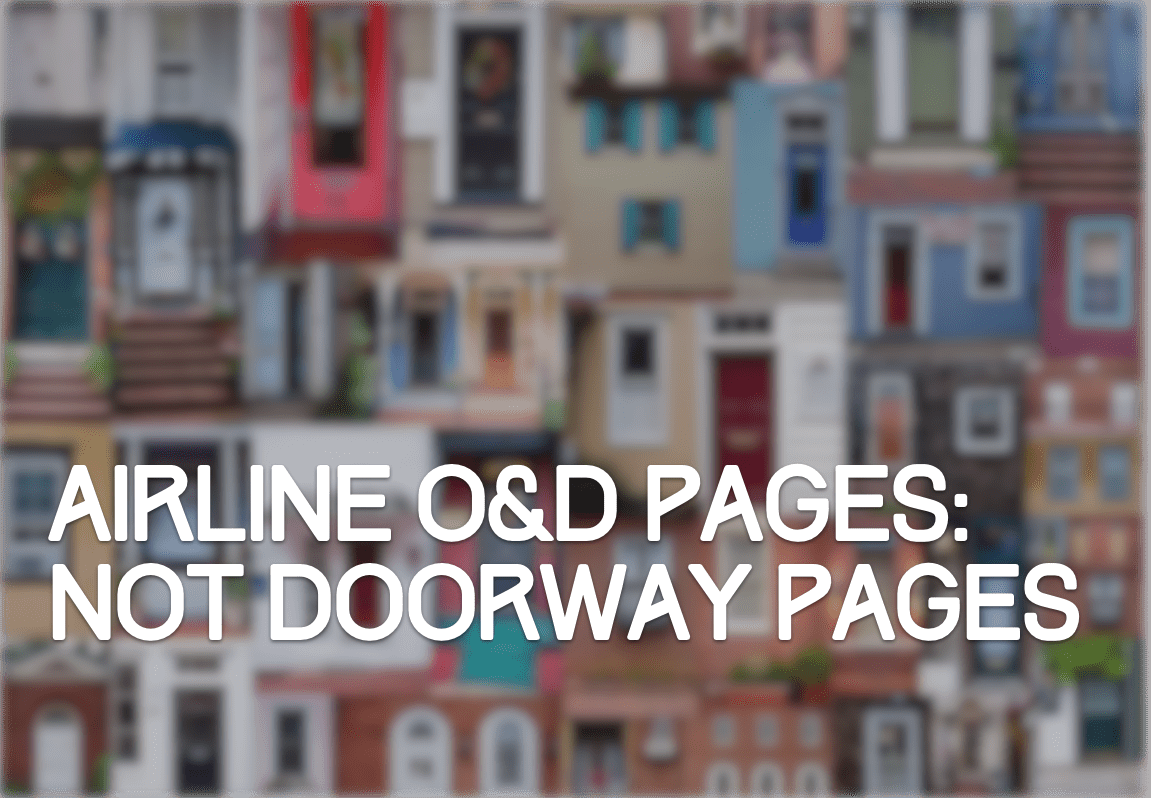Recently, Google announced its intention to change the way its algorithm regards Doorway Pages. This prompted us to spend some time thinking about doorway pages in the context of our little universe of airlines. We asked ourselves the following question: would Google consider destination and route (O&D) pages on an airline’s website to be doorway pages? We are confident that the answer is no.
We recognize that some SEO managers out there may think that our assertion is aggressive or even misguided. However, by asking a few questions about the nature and intent of these pages on an airline’s website, it is clear that this is not the sort of tactic Google is describing when it refers to doorway pages.
Why Route (O&D) Pages are not doorway pages
Is one of the goals of destination and O&D pages on an airline’s website to ultimately guide the visitor into the booking engine for purchase? Of course. But isn’t the goal of every product page on Amazon.com to enable a visitor to select a product for purchase, enter the checkout process and ultimately buy a product? Perceiving destination and O&D pages as strictly an SEO tactic to capture traffic is a fundamental misunderstanding of the integrity that Google constantly strives to elevate in its search results, and ultimately, in the SEO practices of those investing in the Search channel for eCommerce. Google wants to help users find what they are looking for: destination and O&D pages facilitate this; doorway pages hinder it.
In short, having destination and O&D pages on an airline’s website represents eCommerce best practices. Flights are an airline’s product. Destination and O&D pages merchandize these individual products for distinct audiences in an effort to maximize user experience, customer acquisition and website conversion. eCommerce best practices suggest that an online retailer selling a vast multitude of distinct products should create dedicated pages for each product, containing features such as the following:
- Relevant information about the product (e.g. price, schedule, information about the cities and/or airports)
- Access to related products (e.g. flights from the same destination and/or origin)
- Easy initiation of the purchase process of the product (e.g. flight search initiation)
- Ability to share the product with others (e.g. social media functionality)
All this being said, we recognize that if an airline’s website contains thin, virtually identical pages for “Flights to Miami”, “Trip to Miami”, “Travel to Miami”, etc., the airline is executing a doorway page strategy. These “doorways” lead to the same “room”, i.e. a flight to Miami, which is clearly the product sought by the visitor. Moreover, they may not be providing any useful information themselves. However, distinct, content-rich destination and O&D pages are not this.
Answers to Google’s questions on doorway pages
Google has provided a list of questions to enable assessment of whether a collection of webpages constitutes doorway pages, which we answer as follows:
“Is the purpose to optimize for search engines and funnel visitors into the actual usable or relevant portion of your site, or are they an integral part of your site’s user experience?”
Destination and O&D pages are an integral part of an airline’s website: they present the products the airline offers to its customers. Users should clearly find specific information on all routes and destinations an airline offers before entering the booking engine. Simply said, each one of these pages is a product description to inform users prior to the purchase experience.
“Are the pages intended to rank on generic terms yet the content presented on the page is very specific?”
No, these pages are intended to rank for very specific terms such as “flight from Miami to New York”, not terms such as “flights”. If an airline offers this product, it should have a page dedicated to providing relevant information on this particular product.
“Do the pages duplicate useful aggregations of items (locations, products, etc.) that already exist on the site for the purpose of capturing more search traffic?”
O&D pages are generated based on an airline’s specific route list – i.e., its product offering. Their purpose is to present the entire product catalog to the customer. These pages are not indiscriminately generated by algorithmically combining any origin with any destination (A x B). An example of the aggregation Google refers to would be generating and O&D page for every synonym of the word flights, i.e. Travel from Miami to New York”, Fly from Miami to New York, etc.
“Are these pages made solely for drawing affiliate traffic and sending users along without creating unique value in content or functionality?”
O&D pages are not generated for affiliates; they are generated to commercialize each product the airline offers, and designed to initiate the purchase of each one of these individual products.
“Do these pages exist as an “island?” Are they difficult or impossible to navigate to/from other parts of your site? Are links to such pages from other pages within the site or network of sites created just for search engines?”
This is a risk some airlines might run. O&D pages are often provided by a third party, and poor integration with the airline’s main website can cause Google to view these pages as isolated from the root domain. O&D pages (product pages) must be integrated into the root domain via prominent links in the main menu and throughout the rest of an airline’s core website. This is a task each airline with O&D pages must take seriously to prevent the product pages from existing on an “island.”
Closing Thoughts
Destination and O&D pages clearly pass Google’s litmus test for doorway pages, if executed properly. However, we cannot emphasize enough that this strategy must be managed with expertise and discipline to ensure search engines receive these webpages as intended: a useful presentation of an airline’s products – its flights.
By: [post_authors_post_link]

